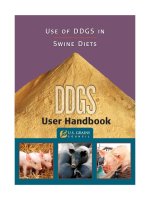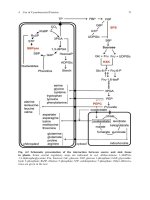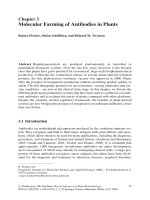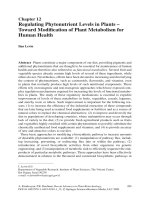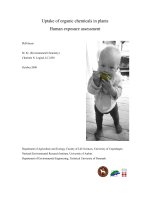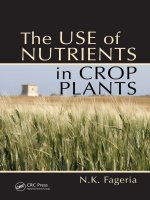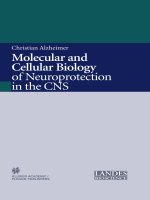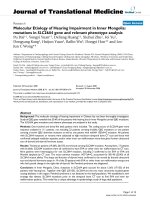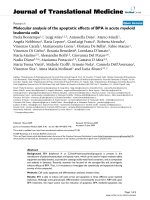Molecular Farming of Antibodies in Plants
Bạn đang xem bản rút gọn của tài liệu. Xem và tải ngay bản đầy đủ của tài liệu tại đây (604.23 KB, 29 trang )
Chapter 3
Molecular Farming of Antibodies in Plants
Rainer Fischer, Stefan Schillberg, and Richard M. Twyman
Abstract Biopharmaceuticals are produced predominantly in microbial or
mammalian bioreactor systems. Over the last few years, however, it has become
clear that plants have great potential for economical, large-scale biopharmaceutical
production. Following the commercial release of several maize-derived technical
proteins, the first plant-derived veterinary vaccine was approved in 2006. Plants
offer the prospect of inexpensive production without sacrificing product quality or
safety. The first therapeutic products for use in humans – mostly antibodies and vac-
cine candidates – are now at the clinical trials stage. In this chapter, we discuss the
different plant-based production systems that have been used to synthesize recombi-
nant antibodies and to evaluate the merits of plants compared with other platforms.
Despite the currently unclear regulatory framework, the benefits of plant-derived
systems are now bringing the prospect of inexpensive recombinant antibodies closer
than ever before.
3.1 Introduction
Antibodies are multisubunit glycoproteins produced by the vertebrate immune sys-
tem. They recognize and bind to their target antigens with great affinity and speci-
ficity, which allows them to be used for many applications, including the diagnosis,
prevention, and treatment of human and animal disease (Andersen and Krummen,
2003; Chadd and Chamow, 2001; Fischer and Emans, 2000). It is estimated that
approximately 1,000 therapeutic recombinant antibodies are under development,
up to one-quarter of which may already be undergoing clinical trials. A large pro-
portion of these antibodies recognize cancer antigens, but others have been devel-
oped for the diagnosis and treatment of infectious diseases, acquired disorders,
R. Fischer (
B
)
Fraunhofer Institute for Molecular Biology and Applied Ecology (IME), Forckenbeckstrasse 6,
52074 Aachen, Germany
e-mail: fi
35
A. Kirakosyan, P.B. Kaufman, Recent Advances in Plant Biotechnology,
DOI 10.1007/978-1-4419-0194-1_3,
C
Springer Science+Business Media, LLC 2009
36 R. Fischer et al.
and even transplant rejection (Gavilondo and Larrick, 2000). As well as having
biomedical applications, antibodies can also be exploited to prevent diseases in
plants (Schillberg et al., 2001), to detect and remove environmental contaminants,
and for various industrial processes such as affinity purification and molecular tar-
geting (Stoger et al., 2005b).
With such a diverse spectrum of uses, the potential market for antibodies is
extremely large and there is considerable interest in high-capacity production tech-
nologies that are robust, economical, and safe. Over the last 15 years, plants have
emerged as convenient, economical, and scalable alternatives to the mainstream
antibody production systems which are based on the large-scale culture of microbes
or animal cells (Chu and Robinson, 2001; Wurm, 2004). In this chapter, we dis-
cuss the advantages and disadvantages of plants for antibody production, the diverse
plant-based systems that are now available, and factors governing the success of
antibody production in plants. We begin, however, with a brief overview of recom-
binant antibody technology.
3.2 Recombinant Antibody Technology
The typical antibody format is the mammalian serum antibody, which comprises
two identical heavy chains and two identical light chains joined by disulfide bonds
(Fig. 3.1). Each heavy chain is folded into four domains, two on either side of a
flexible hinge region, which allows the multimeric protein to adopt its characteristic
shape. Each light chain is folded into two domains. The N-terminal domain of each
of the four chains is variable, i.e., it differs among individual B cells due to unique
Fig. 3.1 Structure of a typical mammalian serum antibody, comprising two identical heavy chains
(gray) and two identical light chains (pink). Solid black lines indicate continuation of the polypep-
tide backbone (simple lines indicate the constant parts of the antibody, curly lines indicate the
variable regions, and thick sectionsrepresent the hinge region). Antibody domains are indicated by
colored circles. Disulfide bonds are represented by gray bars
3 Molecular Farming of Antibodies in Plants 37
rearrangements of the germ-line immunoglobulin genes. This part of the molecule
is responsible for antigen recognition and binding. The remainder of the antibody
comprises a series of constant domains, which are involved in effector functions
such as immune cell recognition and complement fixation. Below the hinge, in what
is known as the Fc portion of the antibody, the constant domains are class-specific.
Mammals produce five classes of immunoglobulins (IgG, IgM, IgA, IgD, and IgE)
with different effector functions. The Fc region also contains a conserved asparagine
residue at position 297 to which N-glycan chains are added. The glycan chains play
an important role both in the folding of the protein and in the performance of effector
functions (Jefferis, 2001).
Antibodies are also found in mucosal secretions, and these secretory antibodies
have a more complex structure than serum antibodies. They are dimers of the serum-
type antibody, the two monomers being attached by an additional component called
the joining chain. There is also a further polypeptide called the secretory component,
which protects the antibodies from proteases (Fig. 3.2).
Antibodies obtained from immunized animals are polyclonal, i.e., derived from
many different B cells. The advantage of monoclonal antibodies, i.e., antibodies
derived from a single clone of B cells, is that their binding specificity does not
vary. The traditional source of monoclonal antibodies is murine B cells. To pro-
vide a constant source of the antibody, B cells of appropriate specificity are fused
to immortal myeloma cells to produce a hybridoma cell line. However, the use of
murine hybridoma-derived antibodies as therapeutics is limited because the murine
components of the antibodies are immunogenic in humans, resulting in a so-called
human antimouse antibody (HAMA) response. Therefore, numerous strategies
Fig. 3.2 Structure of a mammalian secretory antibody, comprising a dimer of the typical serum
antibody and including two additional components, the joining chain (blue disc) and the secretory
component (green disc). Heavy chains are shown in gray and light chains in pink.Solidblack lines
indicate continuation of the polypeptide backbone (simple lines indicate the constant parts of the
antibody, curly lines indicate the variable regions, and thick sectionsrepresent the hinge region).
Antibody domains are indicated by colored circles. Disulfide bonds are represented by gray bars
38 R. Fischer et al.
have been developed to humanize murine monoclonal antibodies (Kipriyanov and
Little, 1999), culminating in the production of transgenic mice expressing the
human immunoglobulin genes (Green, 1999). An alternative approach is to use
phage display libraries based on the human immune repertoires. Phage display is
advantageous because high-affinity antibodies can be identified rapidly, novel com-
binations of heavy and light chains can be tested, and the DNA sequence encoding
the antibody is indirectly linked to the antibody itself (Griffiths and Duncan, 1998;
Sidhu, 2000). This avoids the laborious isolation of cDNA or genomic immunoglob-
ulin sequences from hybridoma cell lines.
The expression of serum-type or secretory-type antibodies as recombinant
molecules requires the preparation and expression of two and four different trans-
genes, respectively. However, this is often an unnecessary complication, because
in many cases, the effector functions conferred by the constant regions are nei-
ther required nor desired. The constant regions of native immunoglobulins are not
required for antigen binding, and the variable regions of the heavy and light chains
can interact perfectly well when joined on the same polypeptide molecule (Chadd
and Chamow, 2001; Fischer and Emans, 2000). Smaller antibody derivatives, which
still require two chains, include Fab and F(ab’)
2
fragments (which contain only the
sequences distal to the hinge region) and minibodies (which contain only part of
the constant portion of the molecule). Other derivatives, such as large single chains,
single-chain Fv fragments (scFvs), and diabodies, contain the variable regions of
the heavy and light chains joined by a flexible peptide chain. Such derivatives are
often more effective as drugs than full-length immunoglobulins because they show
increased penetration of target tissues, reduced immunogenicity, and are cleared
from tissues more rapidly. Another variant is the camelid serum antibody, which is
unique in that it contains only heavy chains. A full-size camelid antibody can, there-
fore, be expressed from a single transgene. Further, more specialized derivatives
include bispecific scFvs, which contain the antigen recognition elements of two dif-
ferent immunoglobulins and can bind to two different antigens, and scFv fusions,
which are linked to proteins with additional functions. Examples of all these anti-
body derivatives are shown in Fig. 3.3.
3.2.1 Expression Systems for Recombinant Antibodies
Most of the recombinant full-length immunoglobulins being developed as pharma-
ceuticals are produced in mammalian cell cultures, a few in hybridoma lines, but
most in immortalized lines that have been cleared by the FDA (Food and Drug
Administration) and equivalent authorities in other countries. These lines include
Chinese hamster ovary (CHO) cells, the murine myeloma cell lines NS0 and SP2/0,
baby hamster kidney (BHK) and human embryonic kidney (HEK)-293 cells, and the
human retinal line PER-C6 (Chu and Robinson, 2001). The main reason for this is
the belief that mammalian cells yield authentic products, particularly in terms of gly-
cosylation patterns. However, there are minor differences in glycan chain structure
between rodent and human cells. For example, human antibodies contain only the
3 Molecular Farming of Antibodies in Plants 39
Minibody
Fab fragment Single chain Fv
fragment (scFv)
Diabody Bispecific scFv
Camelid heavy chain
scFv-fusion
Single
variable
domain
Large single chain
Antigen 1
Antigen 2
Fig. 3.3 Structure of recombinant antibody derivatives and atypical antibody formats, most of
which have been expressed in plants. Heavy-chain derivatives are shown in gray and light-chain
derivatives in pink.Solidblack lines indicate continuation of the polypeptide backbone (simple
lines indicate the constant parts of the antibody, curly lines indicate the variable regions, and thick
sections represent the hinge region). Antibody domains are indicated by colored circles.Disulfide
bonds are represented by gray bars.Thered disc indicates a new functional protein domain in the
scFv fusion protein
sialic acid residue N-acetylneuraminic acid (NANA), while rodents produce a mix-
ture of NANA and N-glycosylneuraminic acid (NGNA) (Raju et al., 2000). There
are many disadvantages to mammalian cell cultures, including the high setup and
running costs, the limited opportunities for scale-up, and the potential contamina-
tion of purified recombinant antibodies with human pathogens. Bacterial fermenta-
tion systems are more cost-effective than mammalian cell cultures and are therefore
preferred for the production of Fab fragments and scFvs, since these derivatives
are not glycosylated. Even so, the yields of such products in bacteria are generally
low because the proteins do not fold properly (Baneyx and Mujacic, 2004). The
main reason for sticking to these systems is that they are well characterized and
established and conform to the strict and extensive regulatory systems governing
biopharmaceutical production.
Several alternative production systems have been explored, some of which are
now well established while others are still experimental. In the former category,
yeast and filamentous fungi have the advantages of bacteria (economy and robust-
ness), but they do have the tendency to hyperglycosylate recombinant proteins
40 R. Fischer et al.
(Gerngross, 2004), while insect cells can be cultured in the same way as mam-
malian cells (although more cheaply) and also produce distinct glycan structures
(Ikonomou et al., 2003). A more recent development is the production of antibodies
in the milk of transgenic animals (Dyck et al., 2003). A disadvantage of animals, in
common with cultured mammalian cells, is the existence of safety concerns about
the transmission of pathogens or oncogenic DNA sequences. Finally, hen’s eggs
could also be used as a production system since they are protein-rich and already
synthesize endogenous antibodies, but they remain a relatively unexplored potential
expression system (Harvey et al., 2002). Plants offer a unique combination of advan-
tages for the production of pharmaceutical antibodies (Twyman et al., 2003, 2005;
Ma et al., 2003; Basaran and Rodriguez-Cerezo, 2008). Their main benefit is the
low production costs, reflecting the fact that traditional agricultural practices and
unskilled labor are sufficient for maintaining and harvesting antibody-expressing
crops. Also, large-scale processing infrastructure is already in place for most crops.
Scale-up is rapid and efficient, requiring only the cultivation of more land. There are
minimal risks of contamination with human pathogens.
The general eukaryotic protein synthesis pathway is conserved between
plants and animals. So plants can efficiently fold and assemble full-size serum
immunoglobulins (as first demonstrated by Hiatt et al., 1989) and secretory IgAs
(first shown by Ma et al., 1995). In the latter case, four different subunits need
to assemble in the same plant cell to produce a functional product, even though
two different cell types are required in mammals. The posttranslational modifica-
tions carried out by plants and animals are not identical to those in mammals, but
they are very similar (certainly more so than in fungal and insect systems). There
are minor differences in the structure of complex glycans, such as the presence in
plants of the residues α-1,3-fucose and β-1,2 xylose, which are absent from mam-
mals (Cabanes-Macheteau et al., 1999). These residues are immunogenic in sev-
eral mammals, including humans, but curiously not in mice and only after multiple
exposures in rats (Gomord et al., 2005; Faye et al., 2005). However, as discussed
in more detail below, there are now many studies that show how the glycan profile
of proteins produced in plants can be “humanized.” As well as full-size antibod-
ies, various functional antibody derivatives have also been produced successfully in
plants, including Fab fragments, scFvs, bispecific scFvs, single-domain antibodies,
and antibody fusion proteins (see Twyman et al., 2005).
3.2.2 Plant-Based Expression Platforms
The most widely used strategy for antibody production in plants is the nuclear trans-
genic system, in which the antibody transgenes are transferred to the plant nuclear
genome. The advantages of this approach when used in our major terrestrial crop
species include the following: (1) transformation is a fairly routine procedure in
many plant species and can be achieved by a range of methods, the two most com-
mon of which are Agrobacterium-mediated transformation and the delivery of DNA-
coated metal particles by microprojectile bombardment; (2) a stable transgenic line
3 Molecular Farming of Antibodies in Plants 41
can be used as a permanent genetic resource; (3) among the various plant systems, it
is the simplest to maintain (once the producer line of transgenics is available) and is
ultimately the most scalable; (4) it is possible to establish master seed banks. Disad-
vantages, compared to other plant systems, include the relatively long development
time required for transformation, regeneration, analysis of transgenics, selection and
bulking up of the producer line, the unpredictable impact of epigenetic events on
transgene expression (e.g., posttranscriptional gene silencing and position effects),
and the potential for transgene spread from some crops through outcrossing. A range
of different crops have been explored for antibody production, and the main cate-
gories are described below.
Leafy crops have two major benefits: they have a large biomass, which translates
to large product yields, and flowering can be prevented (e.g., genetically or by emas-
culation) to avoid the spread of transgenic pollen. On the other hand, leaf tissue is
very watery such that proteins are expressed and accumulate in an aqueous environ-
ment in which they are subject to degradation. This means that antibody-containing
leaves generally have to be processed soon after harvest or otherwise frozen or dried,
which can add significantly to production costs. Tobacco (Nicotiana tabacum L.)
has the longest history as a pharmaceutical production model crop system, having
been used to express the very first plant-derived antibodies and many of the others
since (Table 3.1). The major advantages of tobacco are the well-established technol-
ogy for gene transfer and expression, the high biomass yield (over 100,000 kg/h for
close cropped tobacco, since it can be harvested up to nine times a year), and the
existence of large-scale infrastructure for processing that does not come into con-
tact with the human or animal food chains. Particularly due to the yield potential
and safety features, tobacco could be a major source of plant-derived recombinant
antibodies in the future. Another leafy crop that has been evaluated for antibody
expression is alfalfa (Medicago sativa L.). This has been developed as a production
crop by the Canadian biotechnology company Medicago Inc., and they have secured
a robust IP portfolio covering the use of expression cassettes for biopharmaceutical
proteins in this species. Although not as prolific as tobacco, alfalfa nevertheless pro-
duces large amounts of leaf biomass and has a high leaf protein content. Alfalfa also
lacks the toxic metabolites produced in many tobacco cultivars, which are often
cited as a disadvantage, but instead it contains high levels of oxalic acid, which
can affect protein stability. Alfalfa is particularly useful because it is a perennial
plant that is easily propagated by stem cutting to yield clonal populations. Although
alfalfa has been put on the biosafety “hit list” by the regulators because it outcrosses
with wild relatives, this does not detract from the excellent properties of this species
for antibody production under containment, as in greenhouses or programmed plant
growth chambers. Alfalfa has been used for the production of a diagnostic IgG that
recognizes epitopes specific to the constant regions of human IgG (Khoudi et al.,
1999) and for several other antibodies in development by Medicago Inc.
The problem of protein instability in leafy tissue (see above) can be overcome
by expressing antibodies in the dry seeds of cereals and grain legumes. Several dif-
ferent species have been investigated for antibody production including four major
cereals (maize, rice, wheat, and barley) and two legumes (soybean and pea). The
42 R. Fischer et al.
Table 3.1 Recombinant therapeutic or diagnostic recombinant antibodies produced by molecular farming in plants and reported in the scientific litera-
ture (many antibodies in commercial development remain undisclosed until IP rights have been secured). Antibodies with alternative applications, such as
phytomodulation or the prevention of plant disease, are not listed
Antigen
Antibody
format Production system Comments References
HIV gp120 (2F5) IgG Tobacco, maize, tobacco
suspension cells
Maximum yield ∼75 μg/g seeds Floss et al. (2008), Sack
et al. (2007)
HIV gp120 (2G12) IgG Tobacco, maize Maximum yield ∼100 μg/g seeds Rademacher et al. (2008),
Ramessar et al. (2008c)
B-cell lymphoma, murine
38C13
scFv Virus vectors in tobacco
leaves
Maximum yield 30.2 μg/g leaves McCormick et al. (1999)
Carcinoembryonic antigen scFv, IgG1 Tobacco agroinfiltration Directed to apoplast or ER. Maximum yields 5 μgscFv/g
leaves, 1 μg IgG/g leaves
Vaquero et al. (1999)
dAb Tobacco, agroinfiltration
and transgenic plants
Vaquero et al. (2002)
scFv Rice, rice cell cultures Directed to apoplast or ER. Maximum yields 3.8 μg/g
callus, 29 μg/g leaves, 32 μg/g seed
Torres et al. (1999), Stoger
et al. (2000)
scFv Wheat Directed to apoplast or ER. Maximum yields 900 ng/g
leaves, 1.5 μg/g seed
Stoger et al. (2000)
scFv Pea Directed to rER. Maximum yield 9 μg/g seed Perrin et al. (2000)
CD-40 scFv fusion Tobacco suspension
cells
Secreted into apoplast. Yield not reported Francisco et al. (1997)
Colon cancer antigen IgG Virus vectors in tobacco
leaves
Yield not reported Verch et al. (1998)
Epidermal growth factor
receptor (EGFR)
IgG Tobacco Aglycosylated antibody was directed to the ER and binds
to EGFR expressed on the surface of human tumor cells
Rodriguez et al. (2005)
Human creatine kinase IgG1, Fab Tobacco and
Arabidopsis leaves
Accumulated in nucleolus or apoplast. Maximum yield
1.3% TSP
De Neve et al. (1993), De
Wilde et al. (1998)
3 Molecular Farming of Antibodies in Plants 43
Table 3.1 (continued)
Antigen
Antibody
format Production system Comments References
scFv Tobacco leaves Directed to cytosol or apoplast. Maximum yield 0.01%
TSP
Bruyns et al. (1996)
Rhesus D antigen IgG1 Arabidopsis leaves Reacted with RhD
+
cells in antiglobulin technique and
elicited a respiratory burst in human peripheral blood
mononuclear cells
Bouquin et al. (2002)
Ferritin scFv Tobacco leaves Semenyuk et al. (2002)
Hepatitis B virus surface
antigen
IgG Tobacco leaves Up to 25 mg antibody per kilogram biomass Valdes et al. (2003ª,b)
IgG Tobacco suspension
cells
Complement-dependent cytotoxicity demonstrated Yano et al. (2004)
scFv Tobacco Four different targeting constructs used, ER targeting
achieved 0.22% TSP
Ramírez et al. (2002)
Herpes simplex virus 2 IgG1 Soybean Secreted into apoplast. Yield not reported Zeitlin et al. (1998)
HIV antibodies in blood scFv fusion Tobacco leaves, barley
grains, potato tubers
Maximum yield 150 mg/g Schunmann et al. (2002)
Human
choriogonadotrophin
scFv, dAb,
IgG
Tobacco leaves Secreted into apoplast. Maximum yield 40 mg/kg fresh
weight
Kathuria et al. (2002)
IgG1,
diabody
Tobacco and winter
cherry leaves
Directed to apoplast or ER. Glycan patterns were analyzed Sriraman et al. (2004)
Human IgG IgG1 Alfalfa Secreted into apoplast. Maximum yield 1% TSP Khoudi et al. (1999)
Interleukin-4 scFv Tobacco roots Maximum yield 0.18% TSP Ehsani et al. (2003)
Interleukin-6 scFv Tobacco roots Ehsani et al. (2003)
Protective antigen of
Bacillus anthracis
IgG N. benthamiana Toxin activity was neutralized in vitro and in vivo Hull et al. (2005)
Rabies virus IgG Tobacco Directed to the ER. Activity of the rabies virus was
neutralized. Glycan patterns were analyzed
Ko et al. (2003)
Salmonella enterica
lipopolysaccharide
scFv Tobacco 41.7 μg purified scFv per gram leaf tissue Makvandi-Nejad et al.
(2005)
44 R. Fischer et al.
Table 3.1 (continued)
Antigen
Antibody
format Production system Comments References
Streptococcal surface
antigen (I/II)
sIgA Tobacco leaves Secreted into apoplast. Maximum yield 500 μg/g fresh
weight
Ma et al. (1995)
IgG1 Tobacco leaves Directed to plasma membrane. Maximum yield 1.1% TSP
in leaves
Vine et al. (2001)
IgG1 Secretion from tobacco
roots
Up to 11.7 μg per gram dry root weight per day Drake et al. (2003)
Substance P VH Tobacco leaves Secreted into apoplast. Maximum yield 1% TSP Benvenuto et al. (1991)
Tetanus toxin C IgG2a fused
to tetanus
toxin C
Tobacco Animals immunized with recombinant immune complex
without adjuvant were fully protected against lethal
challenge
Chargelegue et al. (2005)
Tumor-associated
antigen EpCAM
IgG Tobacco Secreted into the apoplast. Binding activity to colon cancer
cells and tumor inhibition activity in nude mice
Ko et al. (2005)
3 Molecular Farming of Antibodies in Plants 45
idea is that such crops would be beneficial for production in developing countries,
where on-site processing would not be possible and a cold chain could not be main-
tained. The accumulation of recombinant antibodies in seeds allows for long-term
storage at ambient temperatures because the proteins accumulate in a stable form
(Ramessar et al., 2008a). Seeds have the appropriate molecular environment to pro-
mote protein accumulation, and they achieve this through the creation of specialized
storage compartments such as protein bodies and storage vacuoles that are derived
from the secretory pathway. Seeds are also desiccated, which reduces the level of
both nonenzymatic hydrolysis and protease degradation. It has been demonstrated
that antibodies expressed in seeds remain stable for at least 3 years at ambient tem-
peratures with no detectable loss of activity (Stoger et al., 2005a).
As well as their advantages in terms of product stability, seed expression might
also be beneficial in terms of downstream processing. This is because seeds have
a relatively simple proteome (therefore minimizing the likelihood that endogenous
proteins would be copurified) and lack the phenolic compounds abundant in leaves
that can interfere with affinity purification. The restriction of recombinant protein
accumulation in seeds also helps to avoid any potentially negative effects on the
growth and development of vegetative plant organs and on humans, animals, and
microorganisms that interact with the plant or feed on its leaves.
Disadvantages of seed crops include the lower overall yields that have been
obtained. The intrinsic yields are in a few cases higher than tobacco (e.g., on a
kilogram-per-kilogram basis of harvested material, rice grains can accumulate more
antibody than tobacco leaves; Stoger et al., 2002), but the vast abundance of har-
vested biomass per hectare from a tobacco crop far outweighs this. Also, seeds
are regarded as viable genetically modified organisms in their own right. So while
the transport of harvested transgenic tobacco leaves should not cause any problems,
the transport of seeds could fall afoul of national and international regulations on the
transport of GMOs (Sparrow et al., 2007; Spök et al., 2008); the seeds would have
to be crushed to flour beforehand and this might offset the advantage of increased
product longevity.
Maize (Zea mays L.) seeds have been investigated as an antibody production
vehicle by Prodigene Inc. following successful demonstrations of the economi-
cal production of other valuable proteins using this system, including avidin and
β-glucuronidase. Initial findings for the expression of a secretory IgA in maize
showed that the four chains were expressed, directed to the cell wall matrix, and
assembled correctly. The product accumulated to 0.3% of total soluble protein
in the T1 seeds, and based on previous results, significant improvements were
anticipated through selective breeding (Hood et al., 2002). An antibody deriva-
tive used for HIV diagnostics has been expressed in barley and has achieved a
yield of 150 μg/g. More recently, the HIV-neutralizing antibody, 2G12, was pro-
duced in maize seeds with a yield >100 μg/g for use as a potential microbicide
(Ramessar et al., 2008c).
Finally, antibodies have also been produced in soybean (Glycine max (L.) Merr.),
although in this particular case, it was expressed constitutively and isolated from the
leaves rather than from the seeds (Zeitlin et al., 1998). Soybean has been investigated
